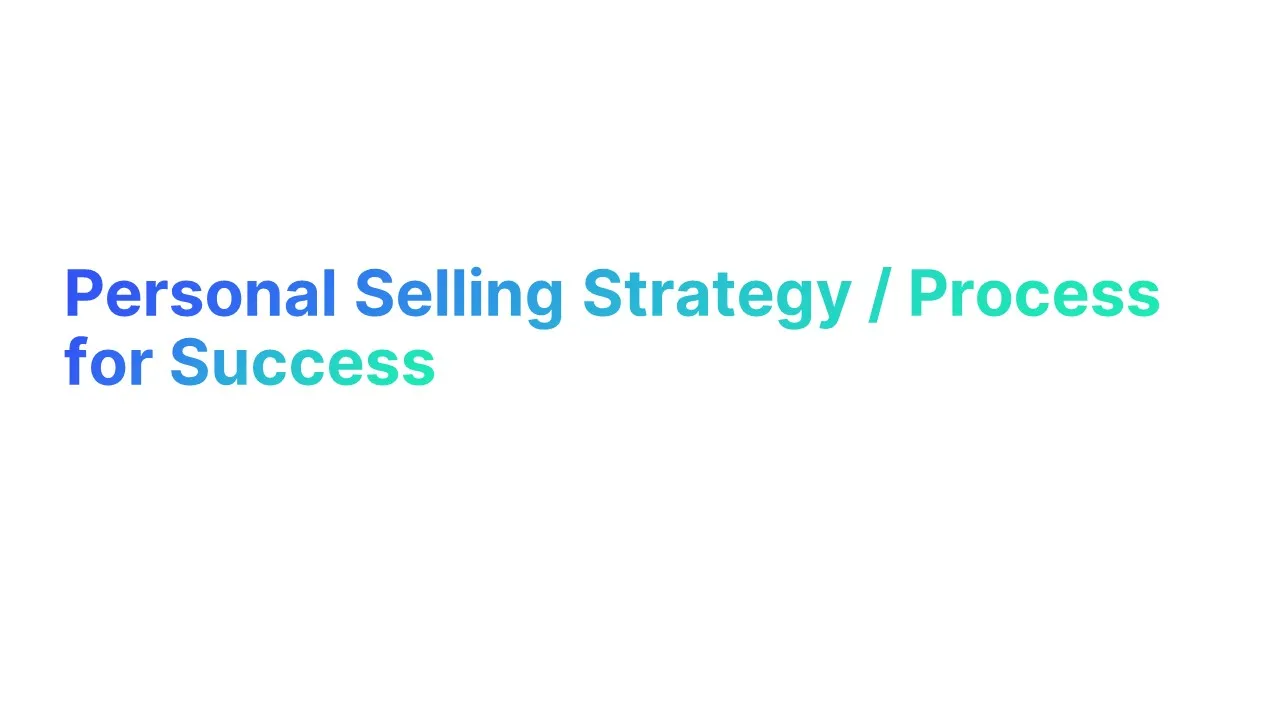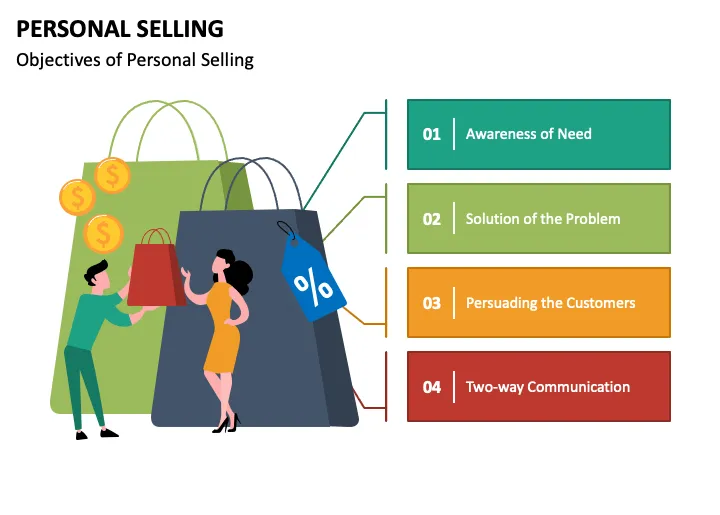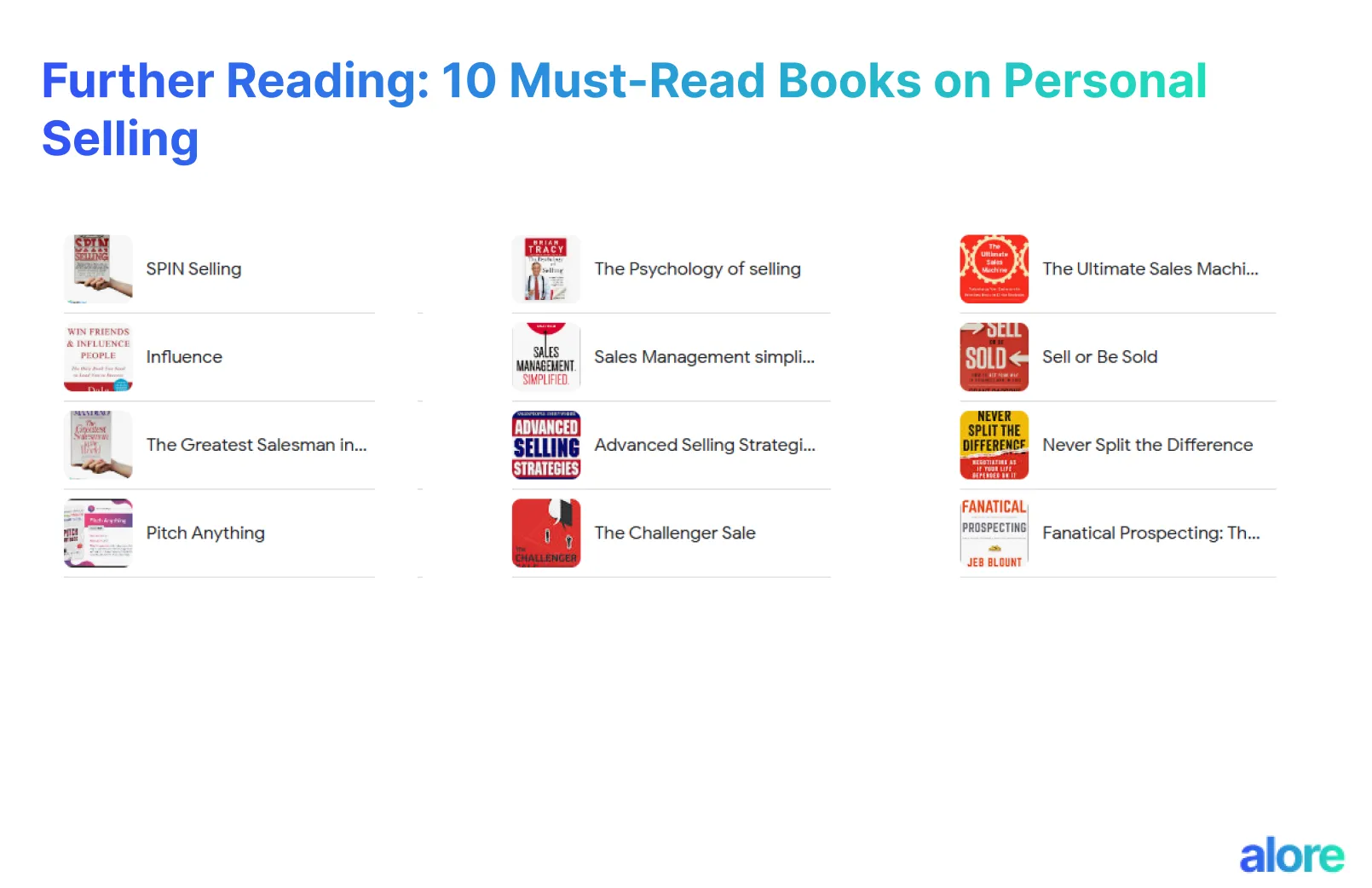Introduction to Personal Selling

What is Personal Selling? Definition and Overview
Personal selling stands as a pivotal component in the sales representative's toolkit, emphasizing direct, face-to-face meetings and personalized communication.
This approach is not just about pitching a product or service;
It's about forging a personal connection, actively listening to the pain points of prospective customers, and offering tailored solutions.
Key to personal selling is building strong customer relationships, shifting from mere transactional exchanges to meaningful interactions.
The Evolution of Personal Selling: From Traditional to Modern Techniques
Traditional methods often relied on sales representatives approaching prospective buyers in retail sales environments or through methods like cold calling.
Modern personal selling strategies, however, embrace a more nuanced approach. It involves understanding the buying process, the importance of customer feedback, and addressing challenges faced by customers with effective sales techniques.
This evolution signifies a move from product-focused to customer-centric models, vital for ensuring customer satisfaction and building strong relationship ties.
Essential Skills Required for Effective Personal Selling
To excel in personal selling, sales reps or anyone interested in selling must master a diverse skill set:
- Understanding Customer Needs: Through active listening and direct communication, sales representatives can better grasp the specific requirements of a potential customer.
- Tailoring Sales Presentations: Each prospective buyer has unique needs, necessitating customized sales presentations that address their specific challenges.
- Building Relationships: More than just closing a sale, personal selling is about developing long-term customer relationships, ensuring repeated business and referrals.
- Providing Value: A sales rep must articulate the value proposition of their product or service clearly, ensuring the prospective customers sees its relevance to their needs.
Incorporating these skills into their personal selling techniques, sales representatives can effectively turn prospective buyers into satisfied customers, ensuring the longevity of customer relationships and fostering a sustainable sales process.
Understanding Personal Selling: Process and Goals
Personal Selling Strategy & How to create a Process for Success

The personal selling process is a comprehensive approach utilized by sales representatives to effectively engage with potential customers and achieve sales objectives.
Here’s a breakdown of the typical stages in the personal selling process:
1. Initial Contact (Sales Representative, Prospective Customer)
Sales representative initiates interaction with a prospective customer. This phase sets the tone of the personal relationship and understanding of the customer's basic needs.
2. Need Assessment (Potential Customers, Pain Points)
In this stage, the sales rep focuses on identifying and understanding the specific needs, pain points, and expectations of the potential customer.
3. Sales Presentation (Product or Service, Sales Techniques)
Here, the representative presents the product or service to the prospective buyer. The presentation is tailored using effective sales techniques to address the identified needs of the customer, demonstrating how the product or service can provide value.
4. Handling Objections (Customer Feedback, Immediate Feedback)
This stage involves providing immediate feedback and reassurances, showing responsiveness to customer feedback.
5. Closing the Sale (Sales Strategy, Customer Satisfaction)
This crucial phase involves persuading the customer to make a purchase. A successful close is achieved through a well-planned sales strategy that ensures the customer feels satisfied and confident in their decision.
6. Follow-Up (Customer Relationships, Personalized Communication)
This stage helps in building long-term customer relationships and can involve personalized communication to check on the customer’s experience and address any further needs or concerns.
Throughout this process, the sales rep's goal is not just to sell but to build a trusting and lasting relationship with the customer, ensuring a positive experience that leads to repeat business and customer loyalty.
Objectives of Personal Selling

The objective of Personal Selling is to:
Building Customer Relationships (Customer Satisfaction, Strong Customer Relationships)
The primary goal is to establish and nurture long-term relationships with customers, ensuring ongoing satisfaction and loyalty.
Understanding Customer Needs (Prospective Customer, Pain Points)
Personal selling aims to deeply understand the unique needs, challenges, and pain points of every prospective customers to offer tailored solutions.
Educating Customers (Product or Service, Educating Customers)
Sales representatives educate potential customers about the features and benefits of a product or service, positioning themselves as knowledgeable and trustworthy advisors.
Achieving Sales Goals (Sales Representative, Sales Strategy)
A key objective is to meet or exceed specific sales targets through strategic selling techniques and effective communication.
Feedback Utilization (Customer Feedback, Sales Process)
Incorporating customer feedback to continuously refine and improve the sales process, ensuring responsiveness to market demands.
These objectives collectively contribute to the overall success of personal selling, focusing on customer-centric approaches to drive sales and foster lasting business relationships.
Importance of Sales Enablement: Enhancing Personal Selling Efficiency
The role of the Sales Enabler involves providing sales teams with the necessary tools, resources, and training to sell more effectively.
Sales enablement ensures that sales reps are well-equipped with up-to-date information about products and services, sales techniques, and customer management systems.
This empowerment enables sales representatives to make informed, direct selling decisions and to personalize their sales approach for every prospective customers.
By streamlining the sales process and providing ongoing sales training, sales enablement helps sales teams meet their targets and fosters an environment of continuous improvement and success in personal selling.
How to Identify Prospective Customers

Identifying prospective customers is an art that requires understanding the nuances of personal selling. It starts with market and online research to pinpoint potential customers. Utilizing techniques such as networking events and analyzing customer feedback can reveal insights into who might be interested in the product or service.
Approaching these prospects involves more than just cold calling;
It’s about making an initial contact that sets the stage for a strong relationship. Sales representatives need to be skilled in person-to-person communication, which is essential in establishing trust and understanding the unique needs of each prospective buyer.
Successful strategies also involve the use of sales scripts that are adaptable to different scenarios and the ability to qualify leads effectively.
Distinguishing between a casual inquiry and a serious interest is crucial for converting potential customers into satisfied, loyal clients.
Types of Personal Selling: Key Techniques & Conversion Strategies for Prospective Customer

Personal selling can transform the way businesses engage with potential customers.
Let's delve into its types and how they effectively convert prospective customers.
1. Transactional Selling
In transactional selling, the sales representative demonstrates a product's features to close a quick sale.
It's about immediate solutions rather than long-term relationships.
For instance, in retail sales, a customer walks in, and the sales rep quickly assesses their needs, offering a product that fits. Here, an understanding of the customer's immediate pain points and a well-prepared sales pitch are vital.
Remember, every interaction is a chance to ensure customer satisfaction, even in brief encounters.
2. Solution Selling
Here, experienced salespeople focus on solving a customer's specific problem.
They engage in direct communication, understanding the customer’s needs, and tailor their pitch accordingly.
For example, a sales representative in office equipment would first identify the unique needs of a business before suggesting a specific product. It's about building a personal sales experience, where genuine interest in the customer's problem is key.
3. Consultative Selling
Consultative selling goes beyond just addressing immediate needs; it's about building strong customer relationships.
Sales reps act more like advisors, using a personalized communication approach.
They might start with a question like, "What challenges are you facing with your current process?" This approach is effective in complex fields like business to business sales, where understanding and solving deeper business challenges is essential.
4. Strategic Selling
Strategic selling involves aligning the sales strategy with the customer's long-term goals.
For instance, a sales team in a tech firm would develop a relationship with a prospective business client, understanding their long-term technological needs and how their product fits into this vision. This approach often requires several face-to-face meetings and a deep understanding of the client's business-to-business environment.
5. Team Selling
Team selling is a collaborative approach where multiple sales representatives work together to close a deal. This is particularly effective in situations where the product or service is complex or when dealing with large potential customers.
For instance, in selling enterprise software solutions, a team comprising a sales rep, a technical expert, and a customer service representative might work together to provide a comprehensive solution to the prospective buyer.
Incorporating these practices in your personal selling strategy can significantly enhance your sales process, making it more effective and customer-centric. Remember, the key is not just to sell but to build a relationship and provide value, ensuring customer satisfaction and fostering long-term loyalty.
Pros and Cons of Personal Selling

Advantages and Disadvantages of Personal Selling
Advantages of Personal Selling:
- Direct Communication: Enables personalized interactions, ensuring clear understanding of customer needs.
- Strong Customer Relationships: Builds trust and loyalty through face-to-face meetings and personal connections.
- Tailored Solutions: Allows sales representatives to customize their sales pitch and presentations to address specific customer pain points.
- Higher Conversion Rates: Personal selling often leads to better conversion rates due to the personalized approach.
- Immediate Feedback: Facilitates real-time responses and adjustments, improving the chances of closing a sale.
- Customer Satisfaction: Enhanced by the personal attention and customized service provided.
Disadvantages of Personal Selling:
- High Cost: Requires significant investment in training sales staff, maintaining a sales team, and managing resources for face-to-face interactions.
- Resource Intensive: Demands extensive time and effort from skilled salespeople.
- Scalability Issues: More challenging to scale compared to digital marketing strategies due to the reliance on individual sales efforts.
- Dependent on Sales Rep Skills: The effectiveness heavily relies on the capabilities and performance of individual sales representatives.
- Limited Reach: Face-to-face selling limits the number of potential customers that can be engaged within a given time frame.
- Potential for Inconsistency: Variability in sales techniques and experiences can lead to inconsistent customer experiences.
How to Balance High Cost and High Reward in Personal Selling
Balancing the high cost and high reward of personal selling involves strategic use of resources and intelligent planning.
A key element is focusing on qualifying leads to ensure sales efforts are directed towards potential customers most likely to convert. This requires a deep understanding of the buying process and the ability to identify genuine prospective buyers.
Developing effective personal selling strategies and investing in sales training can maximize the efficacy of sales presentations and pitches. Additionally, integrating technology and online research can optimize the selling process, reducing costs while maintaining the personal touch that is the hallmark of effective personal selling.
Examples of Personal Selling: Success Stories
Scenario: Car Dealership
- John, a car salesperson, greets customer Emma at the dealership.
- Emma expresses interest in a new car, uncertain of the model.
- John inquires about Emma's lifestyle, driving habits, and preferences, fostering rapport.
- He suggests models focusing on safety and fuel efficiency, pertinent to Emma's daily commute.
- John provides detailed information on safety, fuel economy, and maintenance costs.
- Offers Emma a test drive in her preferred model, demonstrating features and answering questions.
- John discusses financing options and discounts, avoiding high-pressure sales tactics.
- Post-test drive, Emma feels confident and appreciates John's helpfulness, leading to a purchase.
- John completes the sale, ensuring Emma's satisfaction with her decision.
In this scenario, personal selling played a crucial role in Emma's car buying experience. John's approach exemplified the value of personal selling in several ways:
- Building Trust: John's engagement in a friendly conversation and his attentiveness to Emma's preferences helped establish trust. This personal connection is vital in making customers feel valued and understood.
- Tailored Solutions: By understanding Emma's specific needs, John was able to suggest cars that matched her lifestyle and requirements. This personalized approach is often more effective than generic sales tactics.
- Product Demonstration: The test drive and John's detailed explanations allowed Emma to experience the product firsthand and understand its features, directly addressing her concerns.
- Customer Comfort: John's non-pressuring demeanor during the discussion of financing options ensured that Emma felt comfortable and in control of her buying decision.
- Closing the Sale: The combination of product knowledge, personal attention, and a respectful approach led to Emma's satisfaction and ultimately, the successful sale.
Scenario: Real Estate Agent Meeting a Prospective Home Buyer
- Susan, a real estate agent, meets David, a buyer looking for a family home.
- David's needs include a safe neighborhood, proximity to good schools, and a spacious backyard.
- Susan prepares a list of properties matching his criteria.
- They visit a house in a family-friendly area, with Susan highlighting safety, schools, and backyard size.
- She provides detailed information on property taxes, utility costs, and community aspects.
- Throughout the day, they see several properties; Susan notes David's feedback, refining her understanding of his needs.
- Susan remains patient and informative, aligning each property with his family's requirements.
- David shows interest in the first house; Susan offers a second viewing and discusses next steps.
- She promises support throughout the buying process, from price negotiation to closing.
- David appreciates Susan's knowledge, patience, and personalized approach, feeling confident in his decision.
Importance of Personal Selling:
In this case, personal selling was pivotal in guiding David towards his ideal family home. Susan’s approach highlights the significance of personal selling in real estate:
- Understanding Client Needs: Susan's preparation and attentiveness to David's specific requirements demonstrated the importance of understanding client needs in personal selling.
- Tailored Property Selection: By selecting properties that matched David's criteria, Susan showcased the ability to offer tailored solutions, a key aspect of personal selling.
- In-depth Information and Reassurance: Susan's detailed information about each property, from safety features to utility costs, provided David with the reassurance and clarity needed to make an informed decision.
- Building Trust and Rapport: The time spent visiting properties and discussing options helped build a rapport, establishing trust between Susan and David.
- Guidance Through the Buying Process: Susan's offer to assist through all stages of the buying process illustrates the comprehensive support personal selling provides, from selection to closing the deal.
Ideal Situations for Personal Selling
Personal Selling effectiveness is most pronounced in specific scenarios:
Complex Products or Services
Ideal for complex offerings like advanced technology or specialized machinery. Sales reps can provide detailed sales presentations and answer complex queries, ensuring customer understanding.
High-Value Transactions
Essential for significant investments like real estate or luxury goods sales, where a personalized sales strategy can make a substantial difference.
Building Long-term Customer Relationships
Particularly beneficial in B2B environments or industries where nurturing strong customer relationships is vital for ongoing business success.
Market Segments Favoring Personal Interaction
In segments where customers value face-to-face meetings, personal selling can be more effective than other sales techniques.
Custom Solution Sales
When selling products or services that require customization to individual customer needs or pain points, personal selling allows for a more consultative approach.
Gathering Immediate Feedback
Useful in sectors where direct customer feedback is crucial for product improvement or development.
While personal selling has its advantages, such as fostering strong customer relationships and providing personalized communication, it's crucial to weigh these against the high cost and effort involved. This includes the investment in sales training, managing a sales team, and the time and resources required for effective face-to-face selling.
Why Everyone Should Learn Personal Selling
Learning personal selling is important because it:
Boosts Communication Skills: Enhances your ability to convey ideas clearly and persuasively.
Strengthens Persuasion Techniques: Helps in effectively persuading others in various scenarios, not just in sales.
Develops Empathy and Listening: Improves understanding of others' needs and viewpoints.
Builds Confidence: Increases self-assurance in interacting and presenting ideas to others.
Advances Career: Valuable across many professions for promoting ideas, products, or oneself.
Enhances Networking: Aids in building and maintaining professional relationships.
Teaches Adaptability: Useful in diverse situations, from customer interactions to conflict resolution.
Sharpens Problem-Solving: Involves identifying and addressing challenges creatively.
Crucial for Entrepreneurs: Essential for selling a business vision or product effectively.
Further Reading: 10 Must-Read Books on Personal Selling

"Little Red Book of Selling" by Jeffrey Gitomer
- Provides actionable strategies for boosting sales effectiveness.
- Emphasizes the importance of self-belief and a positive attitude in sales.
- Offers insight into understanding and responding to customer needs.
- Includes practical tips for engaging and retaining clients.
- Easy-to-read format with concise, impactful advice.
"SPIN Selling" by Neil Rackham
- Introduces the SPIN (Situation, Problem, Implication, Need-payoff) technique, a research-based sales method.
- Focuses on asking the right questions to understand customer needs.
- Ideal for complex, large-scale sales environments.
- Shifts focus from closing techniques to the overall sales process.
- Based on extensive research and studies of sales transactions.
"Secrets of Closing the Sale" by Zig Ziglar
- Offers over 100 techniques for persuasive selling and closing deals.
- Blends motivational aspects with practical sales tips.
- Ziglar's personal experiences provide relatable, real-world scenarios.
- Highlights the psychological aspects of selling.
- Suitable for all levels of sales professionals.
"To Sell Is Human: The Surprising Truth About Moving Others" by Daniel H. Pink
- Explores the concept that everyone is involved in sales, in one form or another.
- Combines social science, survey research, and intriguing stories.
- Introduces the idea of 'non-sales selling' with practical insights.
- Offers new perspectives on the art and science of selling.
- Emphasizes empathy and the human element in sales.
"The Psychology of Selling" by Brian Tracy
- Focuses on the mindset and psychological approaches in sales.
- Provides techniques for overcoming mental barriers and boosting self-confidence.
- Offers insights into customer psychology and buying behavior.
- Practical tips for goal setting and personal development.
- Emphasizes the importance of a customer-focused sales approach.
"The Ultimate Sales Machine" by Chet Holmes
- Presents strategies for improving sales productivity and performance.
- Focuses on mastering a few key sales strategies for greater impact.
- Combines time management, marketing, and staff development techniques.
- Suitable for both individual salespeople and sales managers.
- Emphasizes the discipline and focus needed in sales.
"The Greatest Salesman in the World" by Og Mandino
- A motivational book that blends philosophy and salesmanship.
- Provides sales advice through a fictional, inspirational story.
- Focuses on personal success principles and their application in sales.
- Offers a unique, philosophical approach to selling.
- Encourages the development of positive habits and attitudes.
"Never Split the Difference" by Chris Voss
- Written by a former FBI negotiator, applying negotiation skills to sales.
- Offers strategies for effective communication and persuasion.
- Focuses on emotional intelligence and intuitive listening.
- Provides real-life negotiation scenarios and solutions.
- Ideal for high-stakes sales and negotiation tactics.
"The Challenger Sale" by Matthew Dixon and Brent Adamson
- Presents a new approach to selling based on challenging customer thinking.
- Focuses on teaching, tailoring, and taking control in sales interactions.
- Based on extensive research of sales performance.
- Challenges conventional sales wisdom and methods.
- Suitable for experienced sales professionals looking for advanced techniques.
"The Science of Selling" by David Hoffeld
- Combines cutting-edge research in social psychology and neuroscience with sales strategies.
- Offers evidence-based techniques to enhance sales effectiveness.
- Focuses on aligning sales techniques with how the brain makes purchasing decisions.
- Provides insights into creating and delivering effective sales messages.
- Ideal for those interested in the scientific aspects of sales persuasion.





.webp)


